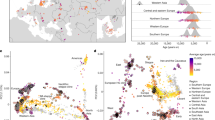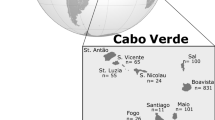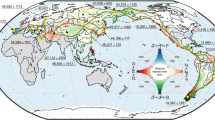Abstract
The New World is the last continent colonized by anatomically modern humans, Homo sapiens. The first migrants entered the New World from Asia through Beringia. It is suggested that there were three streams of Asian gene flow, one major and two additional minor gene flows. The first major migrants took a Pacific coastal route and began spreading to the American continent before the opening of the ice-free corridor. We investigated the diversity of full-length mitochondrial DNA genomes of the Zapotec population, residing in the Mesoamerican region, and reconstructed their demographic history using Bayesian Skyline Plots. We estimated the initial date of gene flow into the New World by Zapotec ancestors at around 17 000–19 000 years ago, which is highly concordant with previous studies. We also show a population decline after the initial expansion. This decline started 4000 years ago, long before European contact with Native Americans. This indicates that other factors including climate change should be considered to explain the observed demographic pattern.
Similar content being viewed by others
Log in or create a free account to read this content
Gain free access to this article, as well as selected content from this journal and more on nature.com
or
References
Fagan, B. M. The Great Journey: The Peopling of Ancient America. London, (University Press of Florida, Gainesville, FL, USA, 2004).
Perez, S. I., Bernal, V., Gonzalez, P. N., Sardi, M. & Politis, G. G. Discrepancy between cranial and DNA data of early Americans: implications for American peopling. PLoS ONE 4, e5746 (2009).
Goebel, T., Waters, M. R. & O'Rourke, D. H. The late Pleistocene dispersal of modern humans in the Americas. Science 319, 1497–1502 (2008).
Fagundes, N. J. R., Kantiz, R., Eckert, R., Valls, A. C. S., Bogo, M. R., Salzano, F. M. et al. Mitochondrial population genomics supports a single pre-Clovis origin with a coastal route for the peopling of the Americas. Am. J. Hum. Genet. 82, 583–592 (2008).
Reich, D., Patterson, N., Campell, D., Tandon, A., Mazieres, S., Ray, N. et al. Reconstructing Native American population history. Nature 488, 370–374 (2012).
Mizuno, F., Gojobori, J., Wang, L., Onishi, K., Sugiyama, S., Granados, J. et al. Complete mitogenome analysis of indigenous populations in Mexico: its relevance for the origin of Mesoamericans. J. Hum. Genet. 59, 359–367 (2014).
Cook, N. D. Born to Die: Disease and New World Conquest, 1492-1650, (Cambridge University Press, Cambridge, UK, 1998).
O'Fallon, B. D. & Fehren-Schmitz, L. Native Americans experienced a strong population bottleneck coincident with European contact. Proc. Natl Acad. Sci. USA 108, 20444–20448 (2011).
Denton, G. H. & Karlén, W. Holocene climatic variations—Their pattern and possible cause. Quaternary Research 3, 155–205 (1973).
Bond, G. A pervasive millennial-scale cycle in North Atlantic Holocene and glacial climates. Science 278, 1257–1266 (1997).
Wanner, H., Beer, J., Bütikofer, J. & Crowley, T. J. Mid- to late Holocene climate change: an overview. Quaternary Science Reviews 27, 1791–1828 (2008).
Drummond, A. J., Suchard, M. A., Xie, D. & Rambaut, A. Bayesian phylogenetics with BEAUti and the BEAST 1.7. Mol. Biol. Evol. 29, 1969–1973 (2012).
Soares, P., Ermini, L., Thomson, N., Mormina, M., Rito, T., Röhl, A. et al. Correcting for purifying selection: an improved human mitochondrial molecular clock. Am. J. Hum. Genet. 84, 740–759 (2009).
Fenner, J. N. Cross-cultural estimation of the human generation interval for use in genetics-based population divergence studies. Am. J. Phys. Anthropol. 128, 415–423 (2005).
Bandelt, H. J., Forster, P. & Röhl, A. Median-joining networks for inferring intraspecific phylogenies. Mol. Biol. Evol. 16, 37–48 (1999).
Tajima, F. Statistical method for testing the neutral mutation hypothesis by DNA polymorphism. Genetics 123, 585–595 (1989).
Arnold, T. G. Radiocarbon dates from the ice-free corridor. Radiocarbon 44, 437–454 (2006).
Brown, C. H. (2010) Pre-Columbian Foodways, (Springer, New York, NY, USA, 2010).
Hendon, J. A. & Joyce, R. A Mesoamerican Archaeology: Theory and Practice, (Blackwell, Malden, MA, USA, 2004).
Shennan, S., Downey, S. S., Timpson, A., Edinborough, K., Colledge, S., Kerig, T. et al. Regional population collapse followed initial agriculture booms in mid-Holocene Europe. Nat. Commun. 4, 2486 (2013).
Acknowledgements
We thank the volunteers in Zapotec who agreed to provide their DNA. We also thank Prof. Saburo Sugiyama and Dr John A. Eimes for the valuable comments on the manuscript. We thank three anonymous reviewers for providing comments that improved the manuscript. This study was supported by State Key Development Program for Basic Research of China, 973 Program (No. 2014CB541701), Zhejiang Provincial Natural Science Foundation of China Grant (No. LZ13H02001) and “Qian Jiang Distinguished Professor” program (to L.W.).
Author information
Authors and Affiliations
Corresponding authors
Ethics declarations
Competing interests
The authors declare no conflict of interest.
Rights and permissions
About this article
Cite this article
Gojobori, J., Mizuno, F., Wang, L. et al. mtDNA diversity of the Zapotec in Mexico suggests a population decline long before the first contact with Europeans. J Hum Genet 60, 557–559 (2015). https://doi.org/10.1038/jhg.2015.55
Received:
Revised:
Accepted:
Published:
Issue date:
DOI: https://doi.org/10.1038/jhg.2015.55



